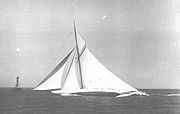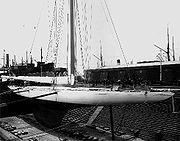.gif)
Reliance (yacht)
Encyclopedia
Reliance was the 1903 America's Cup
defender, the fourth America's Cup defender from the famous designer Nat Herreshoff, and reportedly the largest gaff-rigged cutter ever built.
Reliance was designed to take full advantage of the Seawanhaka
'90-foot'rating rule and was regarded as a "racing freak", suitable only for use in certain conditions. The 1903 America's Cup was the last to be raced according to the Seawanhaka rule.
 Her design took advantage of a loophole in the Seawanhaka '90-foot' rating rule, to produce a racing yacht
Her design took advantage of a loophole in the Seawanhaka '90-foot' rating rule, to produce a racing yacht
with long overhangs at each end, so that when heeled over, her waterline
length (and therefore her speed) increased dramatically (see image at left).
 To save weight, she was completely unfinished below deck
To save weight, she was completely unfinished below deck
, with exposed frames. She was the first racing boat to be fitted with winch
es below decks, in an era when her competitors relied on sheer man-power. Despite this she carried a crew of 64 for racing due to her large sail plan.
From the tip of her bowsprit
to the end of her 108 foot (32.9 m) boom
, Reliance measured 201 feet (61.2 m), and the tip of her mast was 199 feet (60.7 m) above the water (the height of a 20-story building). Everything else was to an equally gargantuan scale; her spinnaker pole
was 84 feet (25.6 m) long, and her total sail
area of 1501 m² (16,156.6 sq ft) was the equivalent of eight 12 meter class yachts.
Reliance was built for one purpose, to successfully defend the America's Cup. Her design philosophy was summed up by Cornelius Vanderbilt
in 1907 when he said "Call the boat a freak, anything you like, but we cannot handicap ourselves, even if our boat is only fit for the junk heap the day after the race.".
Comparison of 87–90 ft America's Cup contenders:
 Her racing career was extraordinarily brief – and undefeated. She bested her America's Cup challenger, Sir Thomas Lipton's
Her racing career was extraordinarily brief – and undefeated. She bested her America's Cup challenger, Sir Thomas Lipton's
Shamrock III, designed by William Fife
, in all three races, with Shamrock III losing by such a margin in the third that she was forced to retire. Her designer immediately proposed the Universal rating rule
to avoid such extreme, dangerous and expensive vessels, which made Reliance an inadequate contestant in subsequent races. There was much speculation as to whether Reliances victory was due to the design of the yacht or the skill of Charlie Barr in sailing her. Lipton himself proposed to allow the two boats to swap crew after the race to decide the matter, but the offer was refused by the owners of Reliance. Her very successful career was short-lived, and she was sold for scrap in 1913.
America's Cup
The America’s Cup is a trophy awarded to the winner of the America's Cup match races between two yachts. One yacht, known as the defender, represents the yacht club that currently holds the America's Cup and the second yacht, known as the challenger, represents the yacht club that is challenging...
defender, the fourth America's Cup defender from the famous designer Nat Herreshoff, and reportedly the largest gaff-rigged cutter ever built.
Reliance was designed to take full advantage of the Seawanhaka
Seawanhaka Corinthian Yacht Club
The Seawanhaka Corinthian Yacht Club is one of the oldest yacht clubs in the Western Hemisphere , located in Oyster Bay, New York, with access to Long Island Sound.-History:...
'90-foot'rating rule and was regarded as a "racing freak", suitable only for use in certain conditions. The 1903 America's Cup was the last to be raced according to the Seawanhaka rule.
Design

Yacht
A yacht is a recreational boat or ship. The term originated from the Dutch Jacht meaning "hunt". It was originally defined as a light fast sailing vessel used by the Dutch navy to pursue pirates and other transgressors around and into the shallow waters of the Low Countries...
with long overhangs at each end, so that when heeled over, her waterline
Waterline
The term "waterline" generally refers to the line where the hull of a ship meets the water surface. It is also the name of a special marking, also known as the national Load Line or Plimsoll Line, to be positioned amidships, that indicates the draft of the ship and the legal limit to which a ship...
length (and therefore her speed) increased dramatically (see image at left).

Deck (ship)
A deck is a permanent covering over a compartment or a hull of a ship. On a boat or ship, the primary deck is the horizontal structure which forms the 'roof' for the hull, which both strengthens the hull and serves as the primary working surface...
, with exposed frames. She was the first racing boat to be fitted with winch
Winch
A winch is a mechanical device that is used to pull in or let out or otherwise adjust the "tension" of a rope or wire rope . In its simplest form it consists of a spool and attached hand crank. In larger forms, winches stand at the heart of machines as diverse as tow trucks, steam shovels and...
es below decks, in an era when her competitors relied on sheer man-power. Despite this she carried a crew of 64 for racing due to her large sail plan.
From the tip of her bowsprit
Bowsprit
The bowsprit of a sailing vessel is a pole extending forward from the vessel's prow. It provides an anchor point for the forestay, allowing the fore-mast to be stepped farther forward on the hull.-Origin:...
to the end of her 108 foot (32.9 m) boom
Boom (sailing)
In sailing, a boom is a spar , along the foot of a fore and aft rigged sail, that greatly improves control of the angle and shape of the sail. The primary action of the boom is to keep the foot of the sail flatter when the sail angle is away from the centerline of the boat. The boom also serves...
, Reliance measured 201 feet (61.2 m), and the tip of her mast was 199 feet (60.7 m) above the water (the height of a 20-story building). Everything else was to an equally gargantuan scale; her spinnaker pole
Spinnaker pole
A spinnaker pole is a spar used in sailboats to help support and control a variety of headsails, particularly the spinnaker. However, it is also used with other sails, such as genoas and jibs, when sailing downwind with no spinnaker hoisted...
was 84 feet (25.6 m) long, and her total sail
Sail
A sail is any type of surface intended to move a vessel, vehicle or rotor by being placed in a wind—in essence a propulsion wing. Sails are used in sailing.-History of sails:...
area of 1501 m² (16,156.6 sq ft) was the equivalent of eight 12 meter class yachts.
Reliance was built for one purpose, to successfully defend the America's Cup. Her design philosophy was summed up by Cornelius Vanderbilt
Cornelius Vanderbilt III
Cornelius Vanderbilt III was a distinguished American military officer, inventor, engineer, and yachtsman, and a member of the prominent American Vanderbilt family.-Biography:...
in 1907 when he said "Call the boat a freak, anything you like, but we cannot handicap ourselves, even if our boat is only fit for the junk heap the day after the race.".
Comparison of 87–90 ft America's Cup contenders:
| Year | LOA | LWL | Sail Area | Mast height | Displacement | |
|---|---|---|---|---|---|---|
| Reliance | 1903 | 43.89 m (144 ft) | 27.43 m (90 ft) | 1501 m² (16,156.6 sq ft) | 67.05 m (220 ft) | 189 tons |
| Ranger Ranger (yacht) The J-class yacht Ranger successfully defended the 1937 America's Cup, defeating the British challenger Endeavour II 4-0 at Newport, Rhode Island. It was the last time J-class yachts would race for the America's Cup.-Construction:... |
1937 | 41.15 m (135 ft) | 26.51 m (87 ft) | 701 m² (7,545.5 sq ft) | 46.98 m (154.1 ft) | 166 tons |
| KZ1 | 1988 1988 America's Cup The 1988 America's Cup was the twenty-eighth running of the America's Cup regatta, and was contested between the defender, San Diego Yacht Club represented by Stars & Stripes, and the challenger, the Mercury Bay Boating Club represented by KZ-1... |
36.57 m (120 ft) | 27.43 m (90 ft) | 627 m² (6,749 sq ft) | 46.78 m (153.5 ft) | 39 tons |
| USA-17 | 2010 | 34.5 m (113.2 ft) | 27.43 m (90 ft) | 1270 m² (13,670.2 sq ft) | 68 m (223.1 ft) | 18 tons |
Career

Thomas Lipton
Sir Thomas Johnstone Lipton, 1st Baronet, KCVO was a Scotsman of Ulster-Scots parentage who was a self-made man, merchant, and yachtsman. He created the Lipton tea brand and was the most persistent challenger in the history of the America's Cup.-Parentage and childhood:Lipton was born in Glasgow...
Shamrock III, designed by William Fife
William Fife
William Fife III OBE , also known as Wm. Fife, Jr., was the third generation of a family of Scottish yacht designers and builders....
, in all three races, with Shamrock III losing by such a margin in the third that she was forced to retire. Her designer immediately proposed the Universal rating rule
Universal Rule
The Universal Rule determined a yachts eligibility to race in the America's Cup from 1914 to 1937. Ships built according to the rule reached their peak in the large J-class yachts....
to avoid such extreme, dangerous and expensive vessels, which made Reliance an inadequate contestant in subsequent races. There was much speculation as to whether Reliances victory was due to the design of the yacht or the skill of Charlie Barr in sailing her. Lipton himself proposed to allow the two boats to swap crew after the race to decide the matter, but the offer was refused by the owners of Reliance. Her very successful career was short-lived, and she was sold for scrap in 1913.
Further reading
- N. L. Stebbins, W. H. Bunting, Steamers, Schooners, Cutters and Sloops: Marine Photographs of N. L. Stebbins Taken 1884-1907 (Houghton Mifflin, Boston, 1974)
- Temple to the Wind - The Story of America's Greatest Naval Architect and His Masterpiece, Reliance by Christopher Pastore (Lyons Press 2005, ISBN 9781592285570)

